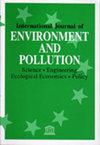使用毒性负荷模型对大鼠时变氰化氢气体暴露进行独立分析
IF 0.3
4区 环境科学与生态学
Q4 ENVIRONMENTAL SCIENCES
International Journal of Environment and Pollution
Pub Date : 2019-01-01
DOI:10.1504/ijep.2019.10026621
引用次数: 0
摘要
美国国防威胁减少局(DTRA)赞助了一项为期两年的实验,于2012年和2013年进行,由美国陆军埃奇伍德化学和生物中心(ECBC)和海军医学研究单位(NAMRU-D)设计和执行,以探索吸入氰化氢气体对大鼠的时变暴露。我们的分析(详见另一篇论文)发现,有毒负荷模型的一组拟合参数(即有毒负荷指数n、概率斜率m和中位致死暴露TL50)不能准确地模拟2.3至30分钟整个实验时间范围内的单一暴露实验数据,但可以在10至30分钟的较长时间尺度上建模。然而,我们考虑的毒性负荷模型都不能很好地拟合新型时变暴露的实验数据,平均浓度和格里菲斯-梅格森模型提供了最不准确的伤亡预测。本文章由计算机程序翻译,如有差异,请以英文原文为准。
Independent analysis of time-varying hydrogen cyanide gas exposures on rats using toxic load-based modelling
The US Defence Threat Reduction Agency (DTRA) sponsored a two-year set of experiments, conducted in 2012 and 2013, that were designed and executed by the US Army's Edgewood Chemical and Biological Center (ECBC) and the Naval Medical Research Unit Dayton (NAMRU-D) to explore time-varying inhalation exposures of hydrogen cyanide gas on rats. Our analysis, detailed in a separate paper, finds that a single set of fitted parameters for the toxic load model (i.e., the toxic load exponent n, probit slope m, and median lethal exposure TL50) cannot accurately model the single exposure experimental data across the experiments' full range of time from 2.3 to 30 minutes but can on the longer timescales of 10 to 30 minutes. However, none of the toxic load models that we considered fits the experimental data for the novel, time-varying exposures well, with the average concentration and Griffiths-Megson models providing the least inaccurate casualty predictions.
求助全文
通过发布文献求助,成功后即可免费获取论文全文。
去求助
来源期刊
CiteScore
1.10
自引率
0.00%
发文量
3
审稿时长
4.5 months
期刊介绍:
IJEP provides an international forum in the field of environment and pollution and addresses early and medium-term challenges involving scientific prediction, modelling and assessment. It focuses on ground-breaking research in the science of environmental pollution, at the early scientific stage. It is one of three key journals which together offer complete coverage of environmental issues: IJETM focuses on technical/engineering, policy and management solutions for environmental problems, and IJGEnvI focuses on future, longer-term environmental scenarios, ecological economics, climate change and biodiversity.

 求助内容:
求助内容: 应助结果提醒方式:
应助结果提醒方式:


